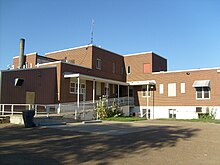Garfield County, Montana
| Garfield County, Montana | |
|---|---|

Garfield County Courthouse in Jordan
|
|
 Location in the U.S. state of Montana |
|
 Montana's location in the U.S. |
|
| Founded | February 7, 1919 |
| Seat | Jordan |
| Largest town | Jordan |
| Area | |
| • Total | 4,847 sq mi (12,554 km2) |
| • Land | 4,675 sq mi (12,108 km2) |
| • Water | 172 sq mi (445 km2), 3.6% |
| Population (est.) | |
| • (2015) | 1,314 |
| • Density | 0.3/sq mi (0/km²) |
| Congressional district | At-large |
| Time zone | Mountain: UTC-7/-6 |
| Website | www |
Garfield County is a county located in the U.S. state of Montana. As of the 2010 census, the population was 1,206. Its county seat is Jordan.
Garfield County is noteworthy as the site of the discovery and excavation of four of the world's dozen or so major specimens (as of 1994) of Tyrannosaurus rex within the county. A cast of the skull of one of these dinosaurs is on display at the Garfield County Museum.
According to the U.S. Census Bureau, the county has a total area of 4,847 square miles (12,550 km2), of which 4,675 square miles (12,110 km2) is land and 172 square miles (450 km2) (3.6%) is water. Its average population density of 0.1058 inhabitants/km² (0.274/sq mi) is the third-lowest of any county outside of Alaska (behind Loving County, Texas and Esmeralda County, Nevada).
As of the census of 2000, there were 1,279 people, 532 households, and 366 families residing in the county. The population density was <1/km² (<1/sq mi). There were 961 housing units at an average density of <1/km² (<1/sq mi). The racial makeup of the county was 99.14% White, 0.08% Black or African American, 0.39% Native American, 0.08% Asian, 0.08% Pacific Islander, and 0.23% from two or more races. 0.39% of the population were Hispanic or Latino of any race. 25.9% were of German, 15.4% English, 14.4% American, 8.1% Scottish, 8.1% Irish, 6.7% Norwegian and 5.5% Scots-Irish ancestry.
...
Wikipedia
